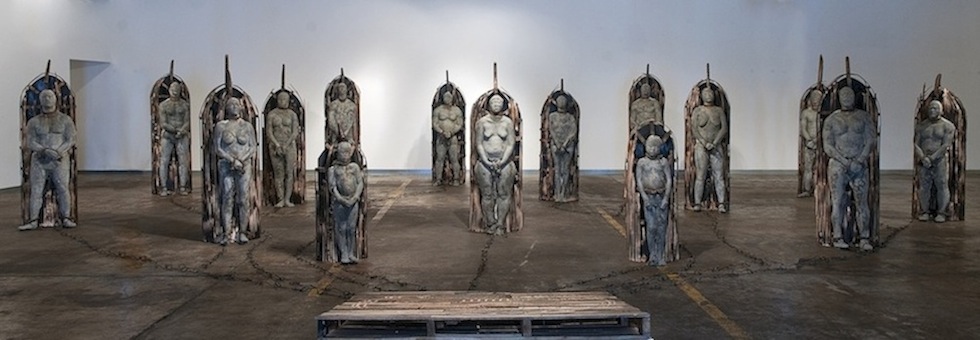
Cash Crop, Installation by Stephen Hayes
MEMORIES OF SLAVERY AND COLONIZATION: HISTORIOGRAPHY, ARTS, AND MUSEUMS
Le Mans University, Nov. 9-10, 2017
Call for papersMemories of Slavery and Colonization: Historiography, Arts, and Museums Le Mans University (Le Mans, France) 9-10 November, 2017
This conference aims to promote a comparative approach to memories of slavery and colonization: we intend to question memory processes through representations of the past in contemporary arts (literature, photography, plastic arts, films) and in-depth studies of their historiographical discourse. Participants will examine the use of images of racial violence, their insertion in artistic and photographic projects, and their narrativisation in literature (novel, life writing, autobiography, biography). They will address the ethical issues underlying the appropriation of these images in a variety of artistic endeavours and analyze their impact on subsequent generations through comparing documents from different periods. From lithography and cinema to photography and writing, the history of colonization is contemporary with the development of mechanical visual reproduction. Disseminated across Europe and America to strengthen colonial domination and to shape the collective imagination, images of colonialism open up question about the representations of colonized people. Such images sometimes adorn literary texts that turn into tools of memory and become “memorial spaces” conveying historical and cultural knowledge. The study of (post)colonial art and photographs – be they made for anthropometric measurements or aimed at learned societies – helps enlighten the relationships between ideology and propaganda, denunciation and activism. In the field of African and African-American literature, writers debate the necessity of retrieving a forgotten history from the colonial period by reconstructing a peoples’ history from memory traces. While one might question the historical legitimacy of reconstructions of the past when influenced by the affect of memory, such literary works further illustrate the notion of religious and cultural syncretism. Literature can be a source of historical knowledge that we also want to examine, broaching such topic as the treatment of the participation of African slaves in the processes of conquest and the role of slaves and freedman in the American, African and Spanish-American independence wars. Popular music and folklore (tales, proverbs) provide spaces of subversion that enabled the dominated population to maintain a link with the past and to transmit traditions undervalued by the dominant culture. Although the presence of African populations on the Hispano-American territories was long downplayed, the cultural and human heritage of former slaves is now acknowledged and respected in such countries as Columbia and Mexico through exhibitions, celebrations, conferences, public debates and publications. The politics of memorialization (including the highly controversial notion of “reparation”) adopted in North America, South America, Africa and Oceania can usefully be analyzed and compared. The historiographical context has considerably changed since the late 1980s with the development of computer-based tools providing access to useful sources for historians and scholars adapting to the digital humanities. One may therefore wonder whether the new digital tools can help bring up memories of slavery and colonization. The cultural heritage of African and Afro-descendant people in North and Latin America also feeds into material and immaterial culture, which provides another topic to be explored. Special attention will be devoted to the scenography of museums and exhibitions, which transmit and stage the memory of slavery in the decolonized territories or in the former Empires. From the National Museum of African American History and Culture (Washington) to the Musée du Quai Branly (Paris), from the Memorial for the abolition of Slavery (Nantes) to the House of Slaves (Goree Island), from the Old Fort of Zanzibar to Cape Coast Castle (Ghana), from the Museu do Negro (Rio de Janeiro) to the Musée Ogier Fombrun (Haïti), mediation activities and museum scenography will provide case studies. The Apartheid Museum and the transformation of Robben Island into a museum in South Africa are also of interest. One may consider the paradoxical situation of these institutions as museums of world culture that exhibit the so-called “primitive” artifacts and civilization without taking into account their function in the European territories. Ethnographic objects may also buttress a disembodied image of slavery and colonization, a representation of the “exotic other” that does not translate the slave’s or the colonized’s experience. Rather than set up a typology of colonial images, the goal of the conference is to spur reflection on the manners in which this variety of visuals has fashioned imaginaries from the colonial era to the 19th century to the postcolonial period. We aim to retrieve some of the forgotten histories of slavery while questioning official and popular memorial processes. Please send your abstract (about 250 words) and a short biography to Benaouda.Lebdai@univ-lemans.fr, Eliane.Elmaleh@univ-lemans.fr et Delphine.Letort@univ-lemans.fr, Claudine.Raynaud@univ-montp3.fr before March 31, 2017.
|

